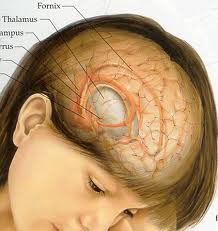A brain tumor is an abnormal growth of tissue in the brain. Unlike other tumors, brain tumors spread by local extension and rarely metastasize (spread) outside the brain. This article focuses on brain tumor’s sign and symptoms, diagnosis and treatment.
Definition
A brain tumor is an abnormal growth of tissue in the brain. Unlike other tumors, brain tumors spread by local extension and rarely metastasize (spread) outside the brain. A benign brain tumor is composed of non-cancerous cells and does not metastasize beyond the part of the brain where it originates. A brain tumor is considered malignant if it contains cancer cells, or if it is composed of harmless cells located in an area where it suppresses one or more vital functions.
Signs and Symptoms
Symptoms do not usually appear until the tumor grows large enough to displace, damage, or destroy delicate brain tissue. When that happens, the patient may experience:
- headaches that become increasingly painful and are most painful when lying down
- nausea and vomiting or sudden attacks of vomiting not accompanied by nausea
- seizures
- dizziness, loss of coordination or balance
- personality changes
- sudden loss of vision
- memory loss
- speech problems
- sensory changes
- mental impairment
- weakness or paralysis on one side of the body
Diagnosis
When a patient experiences one or more of the above symptoms and a neurologist will perform a complete physical examination that include checks for alertness, muscle strength, coordination, eye movements, hearing, touch, and sense of smell, reflexes and response to pain. If the results suggest a patient may have a brain tumor, some or all of these additional diagnostic tests are recommended:
- Computerized Tomography (CT) scan provides a series of detailed pictures of the brain to reveal brain abnormalities.
- Magnetic Resonance Imaging (MRI): may see through the bones of the skull to the tissue underneath.
- Angiogram or Arteriogram: can show the tumor and connect blood vessels.
- Brain Scan: reveals areas of abnormal growth in the brain and records them on special film.
- Functional Imaging : identifies functional pathways in the brain (motor, visual, language) and alerts the surgeon to potential injury to these pathways during surgery before damage could occur.
- Myelogram (sometimes called spine X-ray): detects a spinal cord tumor.
- MR Spectroscopy: shows metabolic activity within a brain tumor.
Treatment
Treatment for brain tumors depends on a number of factors including the type, location and size of the tumor as well as the patient’s age and general health. Treatment methods and schedules differ for children and adults.
Brain tumors are treated with surgery, radiation therapy and chemotherapy.
· Surgery
Surgery is the usual treatment for most brain tumors. To remove a brain tumor, a neurosurgeon makes an opening in the skull. Whenever possible, the surgeon attempts to remove the entire tumor or remove as much of the tumor as possible. Partial removal helps to relieve symptoms by reducing pressure on the brain and reduces the amount of tumor to be treated by radiation therapy or chemotherapy.
In cases tumors can not be removed, doctor may do only a biopsy to determine the type of cells it contains and to decide which treatment to use.
Other advanced techniques during surgery include brain mapping to find functional pathways near tumors, endoscopy to perform biopsies and open spinal fluid pathways through a small scope and advanced frameless stereotaxic computer assisted tumor resections. Intraoperative MRI also is available to help maximize tumor removal.
· Radiation Therapy
Radiation therapy or radiotherapy is often used when surgery is not possible. This therapy uses of high-powered rays to damage cancer cells and stop them from growing.
Radiation therapy may be given in two ways:
- External radiation: comes from a large machine. External radiation may be directed just to the tumor, the surrounding tissue or the entire brain. Sometimes the radiation is also directed to the spinal cord. Radiation also can come from radioactive material placed directly in the tumor, or implant radiation therapy. Depending on the material used, the implant may be left in the brain for a short time or permanently. Implants lose a little radioactivity each day.
- The Gamma knife or stereotactic radiosurgery delivers a single, finely focused, high dose of radiation precisely to its target. High-energy rays are aimed at the tumor from many angles without damaging other brain tissue.
· Chemotherapy
Chemotherapy is the use of drugs to kill cancer cells. Dugs are taken orally or by injection into a blood vessel or muscle or into the cerebrospinal fluid.

